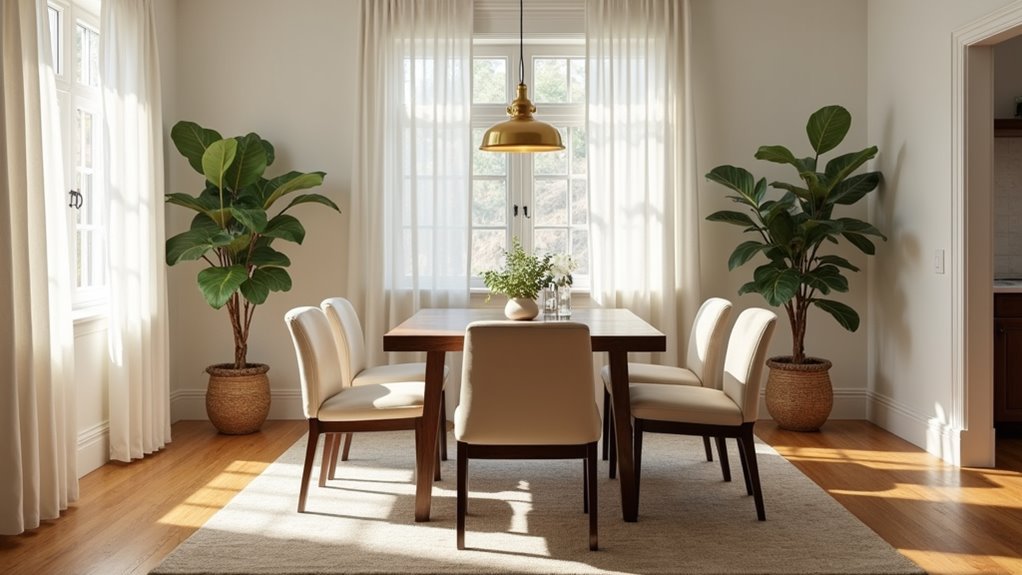Light wood floors require strategic contrast through dark wood dining tables and varied furniture finishes to prevent visual monotony. Wall treatments using mid-tone grays or bold accent colors create focal points while maintaining spatial balance. Natural fiber rugs extending 24 inches beyond table edges add essential texture and warmth. Pendant lighting positioned 30-36 inches above tables provides architectural focus, while warm white bulbs complement wood’s golden undertones. These foundational principles establish the framework for comprehensive dining room transformation.
Key Takeaways
- Choose dark wood dining tables and furniture to create optimal visual contrast against light wood floors for enhanced balance.
- Use light neutrals or mid-tone grays on walls, with bold accent colors like navy blue as focal points.
- Select natural material rugs in wool or jute that extend 24 inches beyond table edges for proper proportions.
- Install pendant lights 30-36 inches above tables with warm white bulbs (2700K-3000K) to complement wood’s golden undertones.
- Add neutral-toned storage like buffets and floating shelves to maintain the light, cohesive aesthetic while maximizing functionality.
Choosing the Right Dining Table and Furniture Colors
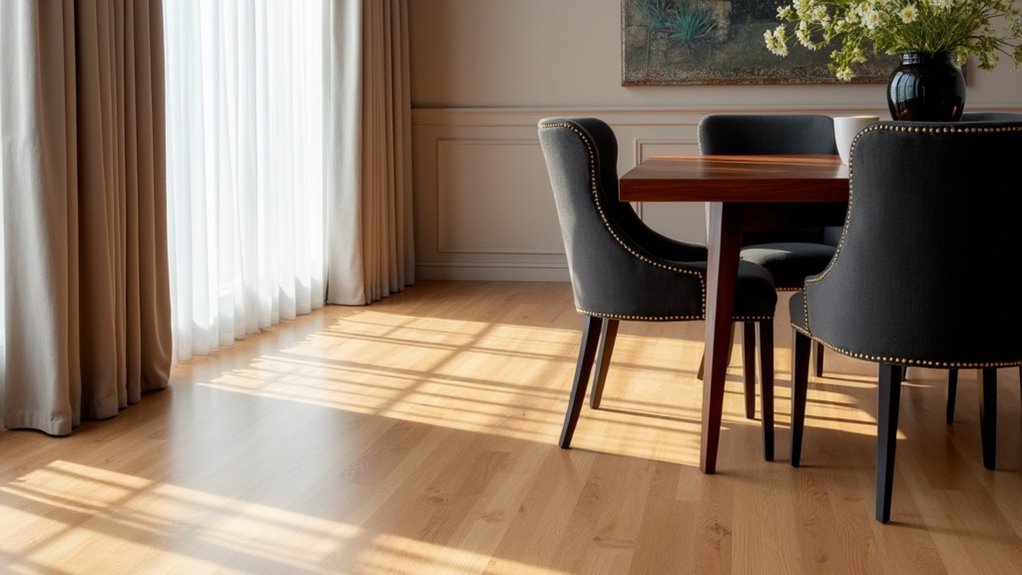
When designing a dining room with light wood floors, selecting furniture colors requires careful consideration of visual weight and tonal relationships. Dark wood dining tables create optimal light contrast against pale flooring, establishing visual balance through strategic material selection.
Dark wood dining tables establish optimal visual balance against light flooring through strategic contrast and thoughtful material selection.
The color palette should incorporate furniture styles that complement rather than match the floor’s undertones, preventing a monotonous appearance.
Modern aesthetics benefit from texture mixing through upholstered seating in pale neutrals or bold accent colors. Black and dark gray pieces provide contemporary edge while maintaining spatial definition. Rich fabrics on chairs soften wood-dominant environments and enhance visual hierarchy.
Strategic furniture styles should vary in finish and material to create layered interest. Mixed metal accents in decorative elements can add sophisticated contrast while maintaining the room’s cohesive aesthetic. Successful color coordination involves selecting pieces several shades darker than flooring to achieve depth without overwhelming the space’s inherent brightness. For optimal functionality, ensure 42-48 inches of clearance around your dining table to allow comfortable movement between furniture pieces. Consider incorporating engineered wood elements in furniture pieces to maintain consistency with flooring materials while adding dimensional variety through different finishes and textures.
Creating Visual Interest Through Wall Treatments and Paint
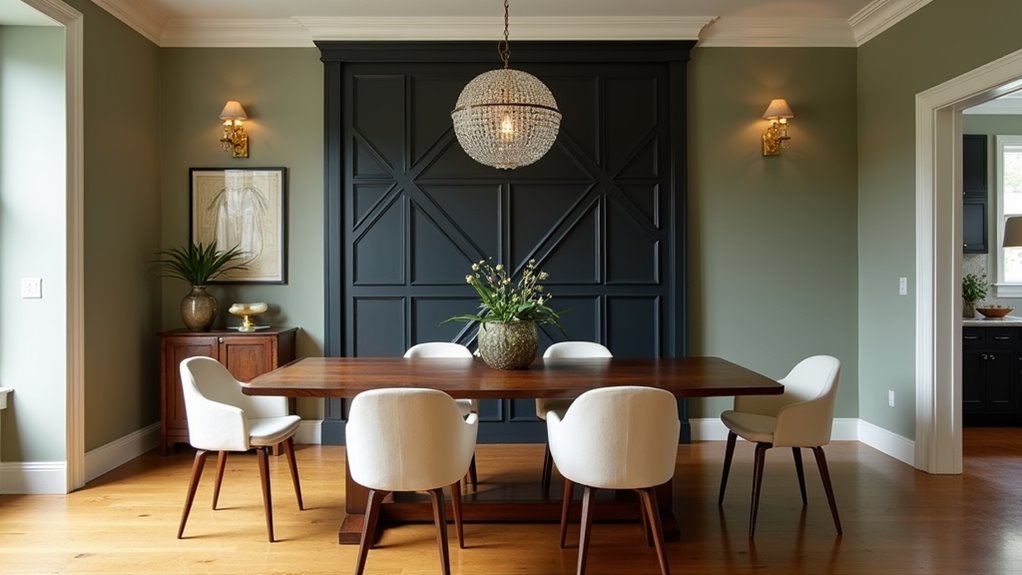
While furniture selection establishes the foundational color relationships in a dining room, wall treatments serve as the primary mechanism for amplifying visual depth and architectural character against light wood flooring.
Strategic wall color options range from light neutrals that enhance spatial brightness to mid-tone grays providing sophisticated contrast with natural wood tones. Bold accent walls in navy blue create focal points without overwhelming the flooring’s prominence.
Textured finishes introduce tactile variety through plaster applications or Venetian techniques that complement wood’s organic qualities. Wainscoting in white or light neutrals adds architectural interest while maintaining visual balance.
Geometric wallpaper patterns and grasscloth coverings reinforce natural aesthetics. Darker accent walls function as visual anchors, grounding the space while emphasizing the light flooring’s contrast potential within the overall compositional framework.
Adding Texture and Warmth With Rugs and Textiles

Strategic rug placement transforms light wood dining floors from mere surfaces into foundational elements that anchor furniture arrangements and define spatial boundaries.
Proper sizing requires extending rugs at least 24 inches beyond table edges, ensuring chairs remain positioned on the textile surface during movement. Natural rug materials like wool, jute, and sisal complement wood’s organic aesthetic while providing necessary durability for high-traffic dining environments.
Low-pile constructions facilitate smooth chair mobility without snagging.
Layering techniques incorporate textured elements through shag, braided, or woven styles that add tactile depth against smooth wood surfaces. Warm-toned textiles balance cooler light wood floors, while neutral palettes maintain visual harmony. Coordinating chair cushions, table runners, and window treatments creates cohesive textile integration that enhances spatial warmth without overwhelming the floor’s natural grain patterns.
Maximizing Ambiance With Strategic Lighting Design
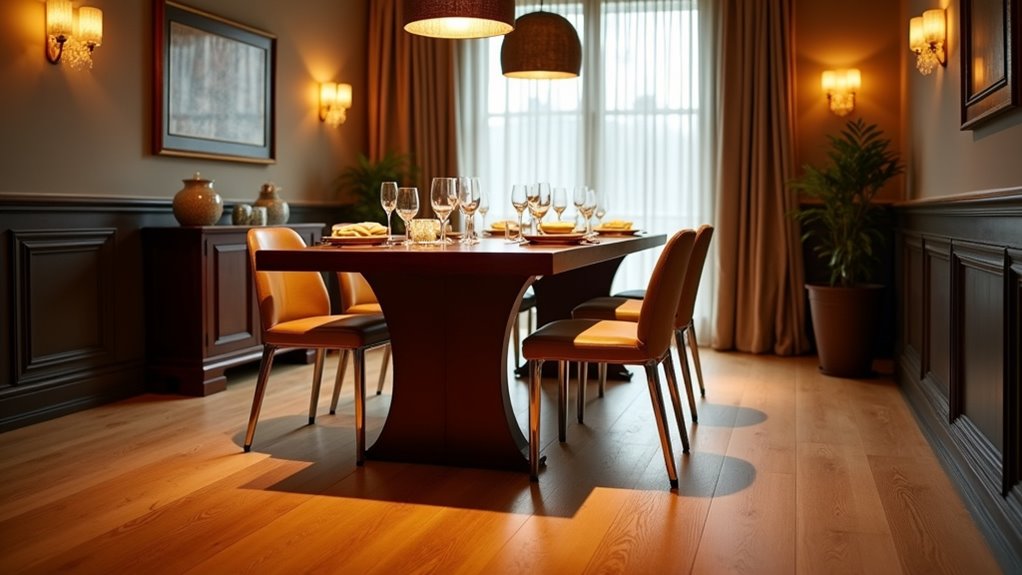
Building upon the foundational warmth established through textile selection, proper illumination design amplifies the natural beauty of light wood floors while creating functional dining environments.
Statement pendant lights positioned at optimal fixture height—typically 30-36 inches above table surfaces—provide essential task lighting while serving as architectural focal points.
Statement pendant lights create dual-purpose illumination, delivering essential task lighting while establishing striking architectural focal points above dining surfaces.
Strategic sconce placement along perimeter walls introduces ambient illumination that highlights the wood’s natural grain patterns through reflected light distribution.
Implementing layered lighting approaches combines overhead ambient sources with targeted accent fixtures, creating dimensional depth throughout the space.
Warm white bulbs at 2700K-3000K color temperatures complement light wood’s golden undertones, establishing cohesive visual harmony.
Dimmable LED fixtures enable atmospheric adjustment for various dining occasions, while properly scaled chandeliers or semi-flush mounts accommodate ceiling height constraints without compromising illumination effectiveness.
Asymmetrical chandeliers with mixed metal and natural wood elements create modern balance through intentional irregularity while complementing the organic warmth of light wood flooring.
Incorporating Functional Accessories and Storage Elements
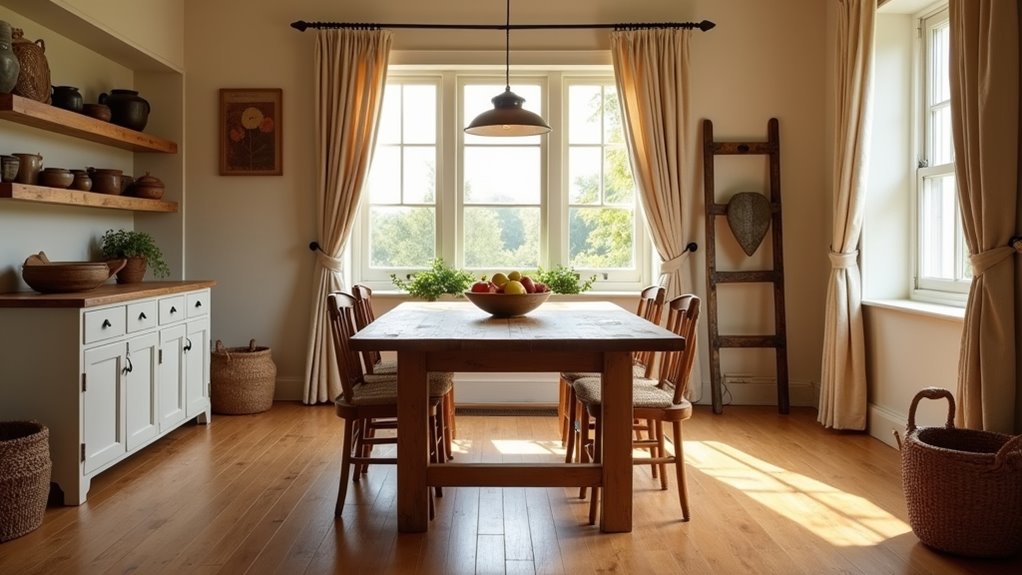
Essential storage solutions transform dining rooms with light wood floors into organized, visually harmonious spaces that balance aesthetic appeal with practical functionality. Buffets and sideboards create optimal pairing with light wood surfaces, delivering substantial storage capacity while maintaining visual continuity.
Modern storage cabinets featuring clean geometric lines establish balanced contrast against warm flooring tones. Floating shelves maximize vertical space without compromising sightlines, while ladder-style units optimize limited floor areas. Multi-functional furniture, including storage benches and modular systems, adapts to varying spatial constraints.
Glass-front cabinets preserve transparency while protecting displayed items. Decorative baskets introduce textural elements within open shelving configurations, while coordinating bar carts extend surface area. Wall-mounted organizational systems maintain accessibility without visual interference.
Neutral-toned storage pieces echo the inherent lightness of wood flooring, creating cohesive design integration throughout the dining environment.
